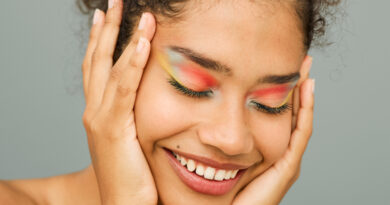If You're Secretly Scared To Try Contouring, Here Are a Makeup Artist's Tips To Make It Easy (And the Product You'll Need To Get Started)
[ad_1]
Pretty much everyone who’s ever attempted contouring has some horror story they could tell—from not blending well enough so the product is still clearly visible on your cheekbones to following the wrong tutorial so you end up looking more scared than snatched.
If you’ve always been secretly afraid to learn how to contour after a failed attempt or from witnessing the endeavors of others, 2024 is your year to try again—but this time with the guidance of Elena Duque, an esthetician and certified makeup artist.
But before you attempt this technique, it’s important to understand what contouring actually does to your face. “Contouring is the art of skillfully manipulating shadows and shading to craft a visual deception of depth,” Duque says. “By strategically applying these techniques, you can effortlessly redefine and reshape your facial features, allowing certain areas to naturally emerge from the rest.”
The first step to contouring correctly? Working with a product that’s easily blendable and is a shade or two darker than your skin tone. Duque encourages people to experiment with different products to find one that works best for them, but one product she recommends—especially to those who want their contour to last—is a cult favorite among makeup enthusiasts: tarte’s Shape Tape contour. Although one of these tubes will usually run you $35, you can grab two of them *and* a contour brush to easily blend out the product for $43 on QVC until the New Year—aka you’ll spend all of 2024 looking incredibly sculpted, for less.
How to contour
Now that you have a makeup-artist-approved product in hand, it’s time to start contouring. Duque says it’s important to start with a clean and moisturized face before applying any makeup, so you can have a smooth canvas to work on.
Next, examine your face shape. A common mistake made by first-time contourers is applying the product in a way that doesn’t suit their face shape, Duque says, which can highlight the wrong features or just look awkward. Finding that sweet spot may take some trial and error, but Duque recommends watching YouTube tutorials by people with a similar face shape to yours or attending makeup workshops led by professional makeup artists.
“Contouring is a skill that takes time to master, so don’t rush the process,” Duque says. “Start with basic techniques and gradually experiment with more advanced methods. Be patient with yourself and embrace the learning curve.”
Once you find a tutorial you want to follow, Duque suggests starting with just a little bit of product, especially the tarte Shape Tape contour since it’s buildable. “Contouring is all about creating subtle shadows and dimension, so it’s important to start with a light hand and build up the intensity gradually,” she says. “It’s easier to add more product than to remove excess.”
Since contouring is primarily used to create the illusion of shadow, Duque says to focus on the hollows of your face, such as the hollows of your cheeks, temples, jawline, and sides of the nose. Once you’ve applied product to these areas, you’ll move on to one of the most important steps of contouring: Blending. In order to make the contour look natural, blending the product out with the handy contour brush that comes with the tarte Shape Tape contour, a damp beauty blender, or your fingers so there are no stark lines is essential.
After you’ve blended the contour, don’t forget to highlight your face. “Contouring and highlighting go hand in hand,” Duque says. “After applying your contour, use a lighter shade or a highlighter to accentuate the high points of your face, such as the tops of your cheekbones, brow bone, and the bridge of your nose.”
Finally, it’s time to set your makeup with a translucent powder or setting spray to make sure it lasts throughout the day, Duque says. Although it may take a few tries to find which contouring technique works for you, Duque says to keep experimenting and you’ll achieve the contour of your dreams.
Our editors independently select these products. Making a purchase through our links may earn Well+Good a commission.
[ad_2]




